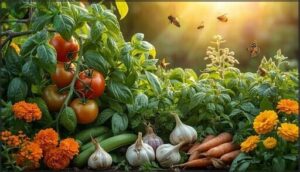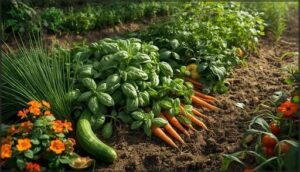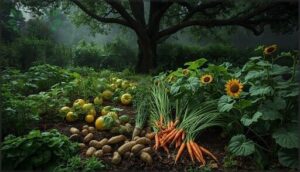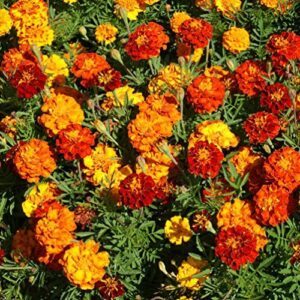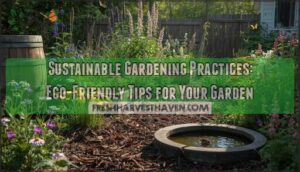This site is supported by our readers. We may earn a commission, at no cost to you, if you purchase through links.

My grandmother could walk through her garden and point to every plant partnership—the basil shielding tomatoes from aphids, marigolds standing guard at the edges, beans fixing nitrogen for hungry corn. She didn’t call it companion planting; she just knew certain vegetables thrived as neighbors while others competed like siblings.
Modern research now backs up what generations of gardeners discovered through observation: strategic plant pairings can reduce pest damage by up to 75%, boost yields, and create a more resilient ecosystem in your backyard.
Whether you’re working with raised beds or container gardens, understanding these plant relationships transforms how you approach your vegetable garden, turning it from a collection of individual crops into a cooperative community.
Table Of Contents
- Key Takeaways
- Essential Benefits of Companion Planting
- Choosing The Best Companion Plant Pairs
- Planning and Managing Your Companion Garden
- Science and Research Behind Companion Planting
- Top 6 Products for Companion Planting Success
- Frequently Asked Questions (FAQs)
- Which vegetables grow well together chart?
- What veggies pair well together?
- What plants grow best together in a vegetable garden?
- What vegetables should not be planted next to each other in a garden?
- What vegetables go best together?
- What is vegetable companion planting?
- Why should you plan your vegetable garden out with companion plants?
- How do you choose plants for companion gardening?
- What is companion planting?
- What is a good companion plant?
- Conclusion
Key Takeaways
- Companion planting reduces pest problems, boosts yields, and makes your garden more resilient by pairing plants that naturally support each other.
- Strategic combinations like tomatoes with basil or beans with corn enhance growth, improve flavor, and support soil health through nitrogen fixation and nutrient cycling.
- Diverse plantings attract beneficial insects and pollinators, leading to better fruit set and natural pest control without relying on chemicals.
- Avoid planting incompatible neighbors, such as beans with onions or tomatoes near corn, to prevent stunted growth, nutrient competition, and increased disease risk.
Essential Benefits of Companion Planting
Companion planting does more than just make your garden look lively—it brings real, practical benefits to your plants and soil. If you’re curious what these advantages look like in action, you’re in the right place.
Here’s what you can expect when you put companion planting to work in your garden.
Natural Pest Deterrence
With companion planting, you utilize nature’s own pest control. Aromatic plant defenses like basil and garlic can cut pest damage by 40–70%. Marigold pest barriers lower nematode and hornworm counts dramatically. Trap cropping benefits, soil-mediated deterrence, and yield damage comparisons all show that diverse plantings mean fewer pests—and less need for chemicals. The inclusion of flowers and herbs increases plant diversity benefits.
- Fewer aphids on your tomatoes
- Less root-knot nematode damage
- Reduced hornworm attacks
- Lower leaf miner infestations
- Healthier, more resilient crops
Attracting Beneficial Insects and Pollinators
When you plant flowers like marigolds and nasturtiums among your vegetables, you’re setting the table for pollinators and beneficial insects. Their visits boost fruit set and protect crops, thanks to smart pollinator attraction strategies and diverse floral traits.
Pollinator habitats increase yield, support insect ecology, and offer real economic benefits, making your garden more resilient and ecologically sustainable. This method can boost pollination rates in your garden.
Enhancing Soil Fertility and Nutrient Cycling
Just as pollinators bring life above ground, healthy soil starts with what’s happening below. Nitrogen fixation from legumes, diverse root systems, and living cover crops all work together to boost soil fertility and nutrient cycling. You’ll notice:
- Peas and beans add nitrogen naturally
- Deep roots break up compacted soil
- Organic matter builds up
- Microbial networks thrive, supporting resilient plant growth
Maximizing Crop Yields and Space Efficiency
When your vegetable garden’s roots work together, you achieve impressive polyculture yields. Vertical growing—like beans climbing corn—optimizes tight growing space.
Pest management and enhanced pollination from companion plants mean less crop loss and more harvest.
Resource partitioning ensures every inch is used efficiently, letting you fully use crop yields without sacrificing plant health or garden beauty.
Weed Suppression and Moisture Retention
Weaving living mulches and cover crops into your garden beds is a smart move for weed suppression and water conservation. Intercropping benefits go beyond weed control—soil health and moisture retention improve as mulch shields roots from evaporation.
For practical results, try these strategies:
- Plant white clover strips
- Use cereal rye cover crops
- Layer organic mulch
- Rotate competitive legumes
Choosing The Best Companion Plant Pairs
Pairing the right plants can make a world of difference in your garden. Some combinations work better than others, offering practical benefits and healthier crops.
Here’s what you need to know about choosing the best companion plant pairs.
Classic Vegetable Pairings (e.g., Tomatoes & Basil)
You’ll get your best results by starting with tried-and-true vegetable pairings that work in harmony. Tomatoes and basil stand out as a garden power duo—field tests show this combination can yield around 200 pounds from just 10 plants, outperforming solo tomato beds by boosting pollinator visits and deterring harmful pests.
Marigold benefits extend to nearly any vegetable, while garlic uses include protecting carrot companions and bean combinations from aphids.
Companion Flowers and Herbs for Vegetables
Flowers and herbs act as effective allies when you weave them throughout your vegetable beds. They increase pollinator attraction by up to 32%, while naturally controlling pests and enriching your soil.
- Marigolds deter aphids, squash bugs, and nematodes from crops like eggplants and onions
- Borage draws in bees while repelling tomato hornworms
- Lavender and thyme attract essential pollinators and beneficial predatory insects
- Nasturtiums serve as trap crops, luring aphids away from cucumbers
Plants That Improve Flavor and Growth
Certain pairings create notable changes in both taste and vigor. Basil planted beside tomatoes triggers biochemical signals that can improve sweetness and overall plant health, while chives near carrots repel pests and boost root flavor.
Nasturtium benefits cucumbers by trapping aphids and improving growth. Coriander effects include deterring potato beetles, and garlic companions help tomatoes and peppers resist disease, improving nutrient supply and soil quality for better plant growth.
Avoiding Incompatible Plant Combinations
Just as some plants work together beautifully, others can sabotage your garden through allelopathic effects and resource competition. Incompatible plants compete for nutrients, trigger growth inhibition, and create crosspest issues that spread disease transmission faster than you’d expect.
- Black walnut releases juglone, causing stunted growth in tomatoes and potatoes within its reach
- Sunflowers suppress bean growth through chemicals that disrupt the soil microbiome
- Broccoli near tomatoes intensifies nutrient competition, reducing yields by up to 40%
- Growth mismatches occur when sprawling squash overshadows carrots, limiting their development
Planning and Managing Your Companion Garden
Once you’ve chosen your companion plant pairings, the next step is turning that knowledge into a thriving garden. Smart planning means thinking through layout, spacing, rotation, and the practical realities of your growing space.
Let’s walk through the key strategies that’ll help you avoid common pitfalls and set your companion garden up for success.
Garden Layout and Spacing Strategies
Your garden layout shapes how well companions perform together. Block planting boosts density by 30% over single rows, perfect for small spaces—think sixteen carrots per square foot. Vertical structures free up 10-15% more growing space while supporting beans or cucumbers.
Sunlight management matters: orient beds north-south for 22% better light penetration. Spacing guidelines prevent overcrowding—give tomatoes 18-24 inches between plants.
Specialized beds organized by crop type simplify care and increase gardening space.
Crop Rotation and Interplanting Techniques
Rotating crops every 2-4 years by plant family slashes disease risk while boosting yields 23% over single-crop systems. Follow heavy feeders like tomatoes with nitrogen-fixing legumes, then light feeders—your soil health benefits through 16-32% organic matter increases.
Intercropping techniques such as the Three Sisters method improve pest disease management by 34% and improve crop resilience through natural weed suppression techniques, maximizing garden yield without chemicals.
Container and Small-Space Companion Gardening
Limited sunlight and container size won’t stop you from growing vegetables at home using companion planting. Vertical gardening structures let you stack crops like tomatoes with basil, boosting yields 30% in tight quarters.
Choose containers at least 12 inches deep, match watering needs carefully, and add organic soil amendments to support nitrogen-fixing legumes alongside heavy feeders—your vegetable garden thrives even on a balcony.
Common Companion Planting Mistakes to Avoid
Even great companion planting intentions can backfire. Overcrowding effects rob smaller vegetables of light, cutting yields up to 40%. Growth habits matter—pairing climbers together creates tangled chaos.
Allelopathy issues arise when plants like black walnut release chemicals that stunt neighbors.
Myth-based pairings lacking evidence waste garden space, and grouping pest-prone companion plants together amplifies infestations rather than solving garden problems.
Science and Research Behind Companion Planting
You might wonder if companion planting is just gardening folklore or if there’s real science backing it up. Researchers have been studying these plant partnerships for years, measuring everything from yields to pest populations.
Here’s what the data shows about how companion planting actually works in the garden.
Evidence of Increased Yields and Plant Health
The numbers tell a compelling story: polyculture yields jump 32% compared to solo planting, while strawberries paired with borage deliver 35% more fruit. Here’s what companion planting benefits deliver for maximizing crop yields and plant health:
Companion planting delivers measurable results: polyculture yields jump 32% while strategic pairings like strawberries with borage produce 35% more fruit
- Soil enzymes like urease boost fertility through better nutrient cycling
- Microbial diversity strengthens roots and disease resistance
- Economic returns increase by $12,800 per acre at wholesale prices
- Pest resilience improves as beneficial microbes outcompete pathogens
These aren’t just theories—they’re abundant harvests you can measure.
Pest and Disease Control Findings
When companion planting deters pests through aromatic masking and trap crops, you’ll see aphid populations drop by 35% on tomatoes paired with basil, and squash bugs decline measurably near nasturtiums.
Disease suppression follows, as garlic companions shift soil microbes to reduce fungal infections.
These pest reduction and disease prevention strategies integrate beautifully into IPM programs, cutting chemical use while beneficial insects thrive in healthier soil adjustments.
Studies on Pollinator and Beneficial Insect Attraction
You’ll attract more pollinators and beneficial insects when habitat management impact includes diverse companion planting flowers in vegetable gardens.
Research shows pollinator visitation rates jump 30% near borage and calendula, while pollinator species richness increases 35% in diverse plantings.
Native plant preference drives stronger populations, with specific plant response data confirming sunflowers and nasturtiums boost attracting beneficial insects by up to 50%.
Soil Quality and Nutrient Research
Diversity beneath the surface transforms your garden’s foundation. Companion planting boosts microbial diversity by 15%, while specific pairings increase beneficial bacteria like Actinobacteria by 20%.
You’ll see nutrient cycling accelerate as soil enzyme activities rise 10–22%, improving soil fertility and nitrogen availability. Disease suppression jumps 22–35%, and ecosystem resilience strengthens through enhanced soil health.
These improvements in soil nutrients translate directly to healthier, more productive vegetables.
Top 6 Products for Companion Planting Success
Getting started with companion planting doesn’t require expensive equipment, but a few well-chosen resources can make the process easier and more successful. From trusted guidebooks that take the guesswork out of plant pairings to carefully selected seeds that attract beneficial insects, these products provide practical support for your garden ecosystem.
Here are six items that can help you build a thriving companion garden from the ground up.
1. Rodale’s Companion Planting Organic Gardening Guide
Rodale Press published its companion planting guide in 1994, and it’s become a trusted starter resource for anyone exploring organic principles in their vegetable garden pairings. You’ll find evidence-based benefits throughout its 160 pages, including recommended pairs like tomatoes with basil and marigolds.
The guide emphasizes improving soil fertility through legume rotations and pest management strategies that attract beneficial insects. While it won’t give you detailed graphs or exhaustive coverage of every crop, it offers practical companion planting benefits for both beginners and experienced gardeners seeking chemical-free solutions.
2. Common Sense Pest Control Solutions
You’ll curb pest populations without harsh chemicals when you apply the least-toxic methods outlined in Common Sense Pest Control. This 736-page Taunton Press resource gives you hundreds of organic pest control tactics for deterring pests through natural repellents and IPM strategies that prioritize beneficial predators over synthetic sprays.
Though published in 1991, its companion planting guidance remains valuable for attracting beneficial insects and reducing pesticides in your garden ecosystem, making it a solid reference alongside modern companion planting techniques for natural pest control methods.
3. The Three Sisters Iroquois Garden
This 21-page Cornell University publication reveals how Iroquois Farming through the Three Sisters—corn, pole beans, and squash—created a thriving Native Gardening system with profound Historical Significance. You’ll discover how Indigenous Agriculture perfected Companion Planting centuries before modern science confirmed its benefits: pole beans climb corn stalks while fixing nitrogen, and squash spreads beneath to suppress weeds and retain moisture.
Though brief, this resource connects you to traditional Crop Rotation wisdom that achieved outstanding yields through intercropping, offering time-tested companion planting inspiration for your own vegetable garden.
4. French Marigold Seeds Mix Vibrant Blooms
Beyond traditional planting systems, French Marigold seeds offer vibrant blooms that function as living pest control in your companion garden. These compact flowers reduce whitefly populations by over 50% near tomatoes and cut nematode numbers in half through root-released compounds.
You’ll attract pollinators and beneficial insects—ladybirds increased 40% in test gardens—while creating a stunning border that blooms for three months.
Select non-GMO seed mixes with 6–12 inch spacing for maximum pest-repellent effect, and watch these workhorses transform both your garden’s health and appearance.
5. Jewel Mix Nasturtium Edible Flower Seeds
Where marigolds guard tomatoes, Jewel Mix Nasturtium works double duty—its peppery flowers bring vitamin C-rich garnishes to your table while deterring garden pests by up to 58%.
You’ll appreciate how this compact variety attracts pollinators and beneficial insects, boosting visitation rates by 67% compared to unplanted areas.
With 86% seed germination rates after overnight soaking, these edible plants thrive in zones 2-11, suppress weeds by 60%, and produce 25-40 blooms per season—perfect for companion planting in beds or containers.
6. Home Grown Premium Bouquet Dill Seeds
Home Grown Premium Bouquet Dill Seeds bring heirloom, non-GMO genetics to your companion planting setup—445 seeds per gram means you can scatter these alongside cucumbers and tomatoes for natural garden pest control.
You’ll see why dill matters: those feathery yellow umbels attract ladybugs and parasitic wasps while seed germination kicks in within 7-21 days. Plant at 1/4-inch depth, and you’ll harvest leaves in 40-55 days.
Research shows dill oil uses include antifungal properties with 100% disease suppression, making these vegetable pairings truly work.
Frequently Asked Questions (FAQs)
Which vegetables grow well together chart?
A vegetable garden companion planting chart is like your gardening roadmap—it shows which vegetables thrive together. Look for classic pairings like tomatoes with basil or carrots with leeks for stronger, healthier plants.
What veggies pair well together?
Tomatoes and basil create a powerful duo, reducing hornworm issues by up to 52% while boosting fruit yields.
Carrots paired with onions slash carrot fly damage by 74%, and beans climbing corn add natural nitrogen, improving growth by 21%.
What plants grow best together in a vegetable garden?
If you’re seeking Beneficial Plant Combinations, try basil with tomatoes, beans with corn, or marigolds with kale.
These Vegetable Garden Guilds encourage Garden Symbiosis, using a Companion Planting Chart to boost Crop Compatibility and yield.
What vegetables should not be planted next to each other in a garden?
If you’re worried about stunted growth or crosspest issues, avoid pairing beans with onions, potatoes with pumpkins, or tomatoes near corn.
Resource competition, allelopathic effects, disease attraction, and shading issues often lead to growth inhibition and nutrient competition.
What vegetables go best together?
For best companion plant combinations, pair basil with tomatoes for flavor enhancement and pest resistance, and beans with corn for nitrogen boost.
Pair onions with carrots for nutrient synergy and growth support.
Avoid planting beans near onions or garlic to prevent yield loss.
What is vegetable companion planting?
As the old saying goes, “Two heads are better than one.” Vegetable companion planting means growing different crops together to create plant relationships that boost organic gardening, biodiversity benefits, and sustainable agriculture—yielding healthier, more productive vegetable gardens.
Why should you plan your vegetable garden out with companion plants?
Planning your garden with vegetable companion planting brings mutual benefits—organic gardening, chemical reduction, and plant vitality.
You’ll deter garden pests, attract beneficial insects, and boost yields, all while weaving a healthy, balanced garden ecosystem from the ground up.
How do you choose plants for companion gardening?
Choosing Companion Plants is like assembling a team for a relay race—match growth requirements, synchronize water needs, and avoid pairings with chemical conflicts.
Prioritize pest management, attract pollinators, and support soil health for the full Benefits of Companion Planting.
What is companion planting?
Companion planting means placing different plant species in close proximity to create mutual benefits. This chemical-free method weaves an organic gardening ecosystem, where companion plants deter pests, boost yields, and enrich soil—maximizing the benefits of plant partnerships.
What is a good companion plant?
Tomatoes and basil make excellent companion plants, offering mutual benefits like enhanced flavor and natural defenses against pests.
This plant pairing demonstrates strong plant compatibility, promotes growth factors, and creates a support system that boosts your vegetable garden’s vitality.
Conclusion
Test the theory yourself: plant basil beside tomatoes, marigolds near beans, and watch the garden’s invisible alliances unfold.
Your vegetable gardening companion planting guide isn’t just a set of rules—it’s an invitation to observe, adapt, and participate in nature’s subtle choreography. Each pairing you choose rewrites the story of your soil and harvest.
When you walk your garden, you’ll see more than plants; you’ll witness a thriving community built by your own thoughtful choices.
- https://www.unsustainablemagazine.com/companion-planting-increases-yield/
- https://ezfloinjection.com/companion-planting-the-ultimate-guide-for-pest-control-and-enhanced-pollination/
- https://www.cvhomemag.com/winning-combinations-companion-planting-in-the-vegetable-garden/
- https://pmc.ncbi.nlm.nih.gov/articles/PMC10331949/
- https://ucanr.edu/blog/uc-master-gardeners-san-mateo-san-francisco-counties/article/better-together-new-science

